调节肠道菌群和预防肠道菌群失调动物模型探讨
肠道菌群失调的危害与预防
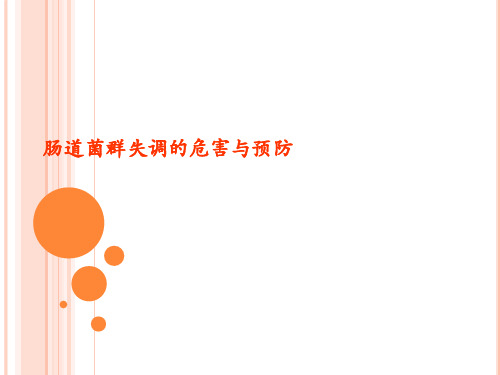
河北医学院附属三院张琳等报告急性细菌性腹泻患儿粪便中双 歧杆菌、类杆菌、乳杆菌、肠球菌明显减少(P<0.01),肠杆菌数量 增加(P<0.05),双歧杆菌与肠杆菌比值(B/E值)降下。随着腹泻症状 消退伴有肠道正常菌群建立,但厌氧菌的上升速度缓慢,与症状的 恢复是同步的,但菌群恢复速度较临床症状好转速度为慢,而且菌群 失调程度与临床症状轻重有关。
五肠、道消菌群化→3系13篇疾(1病994与~2肠008)道菌群失调
消化系疾病→73篇
1、急、慢性腹泻
急性腹泻、肠炎、痢疾时常伴胃肠道 菌群严重比例失调,常住菌(如拟杆菌、 双歧杆菌、肠杆菌)数量减少,外袭病菌 异常增多。慢性腹泻原因较复杂,常见的 有肠易激综合征、急性菌痢后腹泻、吸收 不良综合征及原因不明等,与肠道菌群失 调互为因果。
人体中定居的细菌
人体的皮肤、口腔、肠道、阴道中都有细菌长期存在, 被称为正常菌群。
成人体内的细菌数为1.2千克,约100万亿(1015) 人体携带的微生物主要在肠道,占人体总微生物量约
80%,细菌种类约400-500种,粪便重量的1/3~ 2/5是微生物。这些细菌可分为3类:
有益菌:双歧杆菌、嗜酸乳杆菌 中间菌:粪链球菌、大肠杆菌 有害菌:葡萄球菌、假单孢菌
消化道细菌的分布
口腔:菌群高度复杂,经过胃被胃酸破坏,对 胃肠道影响很小。
胃:除了幽门螺杆菌或相关的菌种外,大多数 是革兰阳性的需氧菌,如链球菌、葡萄球菌、 奈瑟菌、乳酸杆菌和念珠菌,细菌浓度通常 小于103/ml,在无酸的胃中细菌数会明显增 多。幽门螺杆菌是真正的胃内细菌,它是引 起胃炎的主要致病因子,是溃疡病的重要致 病因子。
侯晓华,张锦坤等报告慢性腹泻病人粪便菌 群的检测结果以肠杆菌、粪杆菌、双歧杆菌群 失调有关。
藿香正气水调节小鼠肠道菌群失调的作用研究
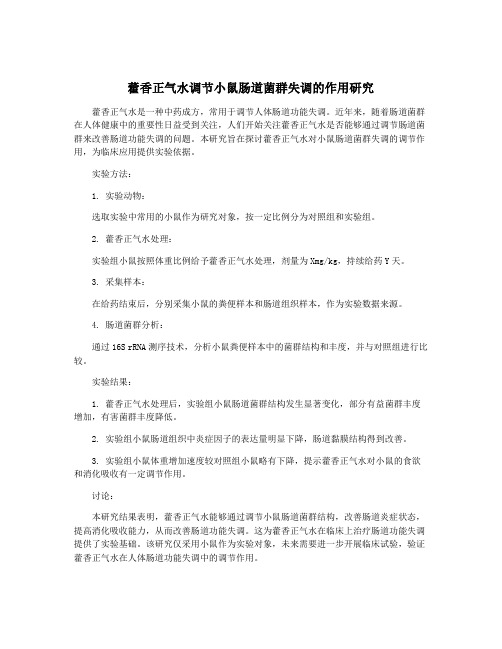
藿香正气水调节小鼠肠道菌群失调的作用研究
藿香正气水是一种中药成方,常用于调节人体肠道功能失调。
近年来,随着肠道菌群在人体健康中的重要性日益受到关注,人们开始关注藿香正气水是否能够通过调节肠道菌群来改善肠道功能失调的问题。
本研究旨在探讨藿香正气水对小鼠肠道菌群失调的调节作用,为临床应用提供实验依据。
实验方法:
1. 实验动物:
选取实验中常用的小鼠作为研究对象,按一定比例分为对照组和实验组。
2. 藿香正气水处理:
实验组小鼠按照体重比例给予藿香正气水处理,剂量为Xmg/kg,持续给药Y天。
3. 采集样本:
在给药结束后,分别采集小鼠的粪便样本和肠道组织样本,作为实验数据来源。
4. 肠道菌群分析:
通过16S rRNA测序技术,分析小鼠粪便样本中的菌群结构和丰度,并与对照组进行比较。
实验结果:
1. 藿香正气水处理后,实验组小鼠肠道菌群结构发生显著变化,部分有益菌群丰度增加,有害菌群丰度降低。
2. 实验组小鼠肠道组织中炎症因子的表达量明显下降,肠道黏膜结构得到改善。
3. 实验组小鼠体重增加速度较对照组小鼠略有下降,提示藿香正气水对小鼠的食欲和消化吸收有一定调节作用。
讨论:
本研究结果表明,藿香正气水能够通过调节小鼠肠道菌群结构,改善肠道炎症状态,提高消化吸收能力,从而改善肠道功能失调。
这为藿香正气水在临床上治疗肠道功能失调提供了实验基础。
该研究仅采用小鼠作为实验对象,未来需要进一步开展临床试验,验证藿香正气水在人体肠道功能失调中的调节作用。
脾虚模型大鼠肠道菌群分布及时效性研究
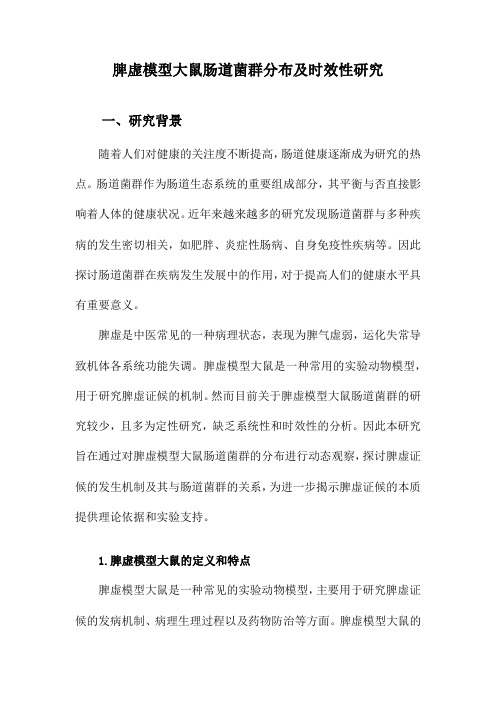
脾虚模型大鼠肠道菌群分布及时效性研究一、研究背景随着人们对健康的关注度不断提高,肠道健康逐渐成为研究的热点。
肠道菌群作为肠道生态系统的重要组成部分,其平衡与否直接影响着人体的健康状况。
近年来越来越多的研究发现肠道菌群与多种疾病的发生密切相关,如肥胖、炎症性肠病、自身免疫性疾病等。
因此探讨肠道菌群在疾病发生发展中的作用,对于提高人们的健康水平具有重要意义。
脾虚是中医常见的一种病理状态,表现为脾气虚弱,运化失常导致机体各系统功能失调。
脾虚模型大鼠是一种常用的实验动物模型,用于研究脾虚证候的机制。
然而目前关于脾虚模型大鼠肠道菌群的研究较少,且多为定性研究,缺乏系统性和时效性的分析。
因此本研究旨在通过对脾虚模型大鼠肠道菌群的分布进行动态观察,探讨脾虚证候的发生机制及其与肠道菌群的关系,为进一步揭示脾虚证候的本质提供理论依据和实验支持。
1.脾虚模型大鼠的定义和特点脾虚模型大鼠是一种常见的实验动物模型,主要用于研究脾虚证候的发病机制、病理生理过程以及药物防治等方面。
脾虚模型大鼠的定义主要包括两个方面:一是具有典型的脾虚证候特征,如食欲不振、便溏、乏力等;二是在实验室条件下,通过一系列操作手段模拟脾虚状态,使大鼠出现类似人类脾虚的症状。
脾虚模型大鼠作为一种常用的实验动物模型,具有明确的定义和特点,为研究脾虚证候提供了有力支持。
在未来的研究中,可以通过对脾虚模型大鼠进行深入探讨,揭示脾虚证候的病理生理机制,为临床治疗提供理论依据。
2.肠道菌群与健康的关系肠道菌群是指生活在人体肠道内的微生物群落,包括细菌、真菌、病毒等多种生物。
近年来越来越多的研究发现肠道菌群与人类的健康密切相关,研究表明肠道菌群失调可能导致多种疾病,如肥胖、炎症性肠病、自身免疫性疾病等。
因此维护肠道菌群的平衡对于人类健康具有重要意义。
在脾虚模型大鼠的研究中,肠道菌群的分布和变化也受到了关注。
脾虚模型大鼠是指通过喂养特定食物或药物导致脾脏功能减弱的实验动物。
乳酸菌和双歧杆菌制剂对小鼠肠道菌群失调模型的调节作用
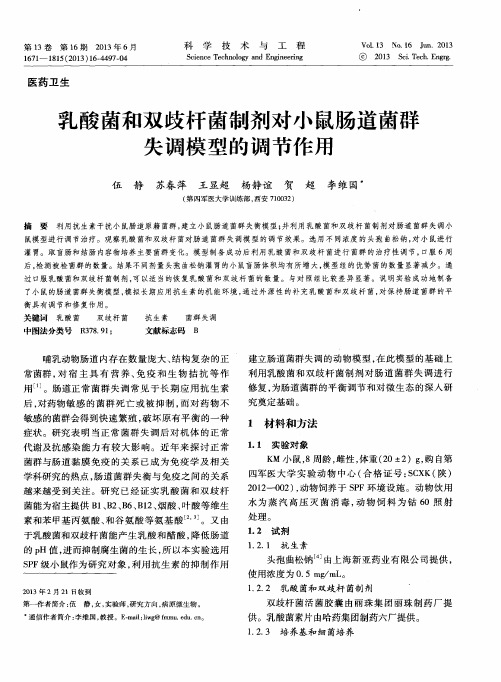
第 1 6期
2 0 1 3年 6月
科
学
技
术
与
工
程
Vo 1 . 1 3 N o . 1 6 J u n .2 0 1 3
1 6 7 1 —1 8 1 5 ( 2 0 1 3 ) 1 6 - 4 4 9 7 — 0 4
S c i e n c e T e c h n o l o g y a n d E n g i n e e r i n g
于选择肠球菌 ; 乳酸杆 菌选择 培养基 ( MR S ) 用 于
菌、 乳酸菌、 双 歧杆 菌 的菌 落数 , 并 以每 克 盲 肠 内容 物 中菌落 数 的常用 对数 表示 。
1 . 3 . 4 双歧杆 菌和 乳酸 杆 菌的调 节治 疗
选择乳酸杆 菌 ; 双歧杆 菌选择 培养 基 ( B B L) 选 择
后, 检测被检菌群 的数量 。结果 不同剂量头孢 曲松钠灌 胃的小 鼠盲肠体 积均有所增 大 , 模 型组的优势 菌的数量 显著 减少。通
过 口服 乳酸菌和双歧杆菌制剂 , 可 以适 当的恢复乳酸 菌和双 歧杆 菌的数量 。与对 照组 比较 差异 显著 。说 明实 验成功地 制备 了小 鼠的肠道 菌群 失衡模 型 , 模 拟长 期应用抗 生素的机 能环境 , 通过 外源性 的补充 乳酸菌和双 歧杆 菌 , 对 保持肠道 菌群 的平 衡具有调 节和修 复作用。
关键词
乳酸菌
双歧杆菌
抗 生素 文献标 志码
菌群 失调 B
中图法分类号
1 1 3 7 8 . 9 1 ;
哺乳 动 物肠 道 内存 在 数 量 庞 大 、 结 构 复 杂 的 正 常菌 群 , 对 宿 主 具有 营养 、 免 疫 和 生 物 拮 抗 等 作
藿香正气水调节小鼠肠道菌群失调的作用研究
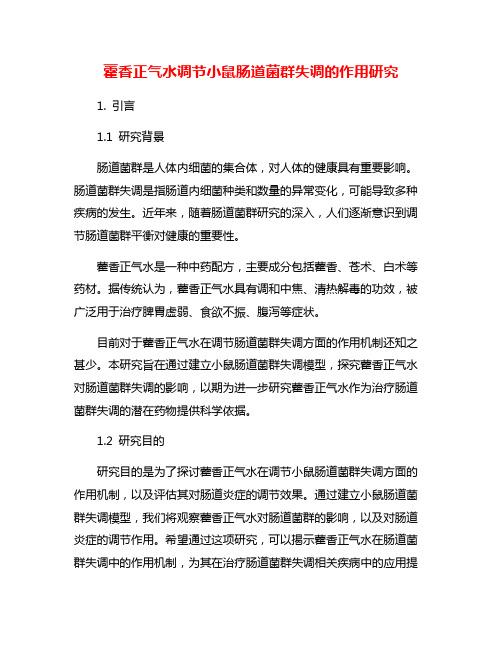
藿香正气水调节小鼠肠道菌群失调的作用研究1. 引言1.1 研究背景肠道菌群是人体内细菌的集合体,对人体的健康具有重要影响。
肠道菌群失调是指肠道内细菌种类和数量的异常变化,可能导致多种疾病的发生。
近年来,随着肠道菌群研究的深入,人们逐渐意识到调节肠道菌群平衡对健康的重要性。
藿香正气水是一种中药配方,主要成分包括藿香、苍术、白术等药材。
据传统认为,藿香正气水具有调和中焦、清热解毒的功效,被广泛用于治疗脾胃虚弱、食欲不振、腹泻等症状。
目前对于藿香正气水在调节肠道菌群失调方面的作用机制还知之甚少。
本研究旨在通过建立小鼠肠道菌群失调模型,探究藿香正气水对肠道菌群失调的影响,以期为进一步研究藿香正气水作为治疗肠道菌群失调的潜在药物提供科学依据。
1.2 研究目的研究目的是为了探讨藿香正气水在调节小鼠肠道菌群失调方面的作用机制,以及评估其对肠道炎症的调节效果。
通过建立小鼠肠道菌群失调模型,我们将观察藿香正气水对肠道菌群的影响,以及对肠道炎症的调节作用。
希望通过这项研究,可以揭示藿香正气水在肠道菌群失调中的作用机制,为其在治疗肠道菌群失调相关疾病中的应用提供科学依据。
该研究旨在为开展进一步的临床试验奠定基础,探讨藿香正气水作为潜在的治疗肠道菌群失调的药物。
最终我们希望能够为临床治疗提供新的药物选择,提高肠道健康水平,改善相关疾病的预后和治疗效果。
2. 正文2.1 藿香正气水的成分及功效藿香正气水是一种中药复方制剂,主要由藿香、紫苏、荆芥、枳实等药材组成。
藿香正气水具有疏风解表、宣肺理气、祛湿化痰的功效,常用于治疗脾胃虚弱、胃肠不和、食滞积滞等症状。
藿香具有开窍宣肺、理气健胃的作用;紫苏具有疏风解表、行气宽中的功效;荆芥具有宣肺祛风、行气解表的作用;枳实具有燥湿化痰、止呕调中的功效。
这些药材组合在一起,可以协同作用,调节肠道功能,促进食物消化和吸收。
研究表明,藿香正气水对小鼠肠道菌群失调具有一定的调节作用。
通过调节肠道菌群的平衡,藿香正气水可以减缓肠道炎症反应,改善肠道黏膜屏障功能,促进有益菌群的增殖,抑制有害菌群的繁殖,从而维护肠道健康。
消化系统疾病实验设计方法

消化系统疾病实验设计方法在医学领域中,消化系统疾病的研究和探索一直是一个重要的课题。
为了更好地了解和治疗这些疾病,科学家们经常设计各种实验来模拟和研究消化系统的功能和疾病机制。
本文将介绍一些常用的消化系统疾病实验设计方法,以期提供一些有价值的参考。
一、动物模型实验设计在研究消化系统疾病时,常常需要使用动物模型来模拟人体情况。
以下是几种常见的动物模型实验设计方法:1. 胃溃疡实验设计:可以使用小鼠或大鼠作为实验动物,通过给予其辛辣食物、非甾体抗炎药物或给予胃粘膜损伤剂等方法,诱发胃溃疡发生。
实验过程中需要监测动物的食物摄入量、胃酸分泌和胃黏膜损伤程度等指标。
2. 肝炎模型实验设计:常用小鼠或大鼠模型,通过注射病毒、化学物质或高脂饮食等方法,诱发肝炎发生。
实验过程中需要监测动物的肝功能指标、炎症反应水平和组织损伤程度等。
3. 肠炎模型实验设计:可以使用小鼠或大鼠进行实验,通过给予动物温度、化学物质或诱导免疫反应等方法,模拟肠炎的发生。
实验过程中需要检测动物的肠道菌群、免疫反应水平和肠道屏障功能等指标。
二、细胞培养实验设计细胞培养实验是研究消化系统疾病的重要手段之一。
以下是几种常见的细胞培养实验设计方法:1. 胃酸分泌实验设计:可使用胃黏膜细胞株如RGM-1,通过给予不同刺激物如组胺、胆碱等来模拟胃酸分泌过程。
实验过程中需要检测细胞分泌的胃酸量和相关信号通路的激活程度等。
2. 肠道细胞炎症实验设计:可以使用肠道上皮细胞株如Caco-2,通过给予细胞不同的炎症刺激如TNF-α、细菌脂多糖等,模拟肠道炎症反应。
实验过程中需要检测细胞炎症因子的分泌水平和细胞屏障功能等。
3. 肝细胞损伤实验设计:常用肝细胞株如HepG2进行实验,通过给予细胞不同的损伤因子如酒精、药物等,模拟肝细胞的损伤过程。
实验过程中需要检测细胞的损伤程度、氧化应激水平和修复能力等。
三、分子生物学实验设计分子生物学实验可以揭示消化系统疾病的分子机制和相关信号通路。
藿香正气水调节小鼠肠道菌群失调的作用研究

藿香正气水调节小鼠肠道菌群失调的作用研究【摘要】本研究旨在探讨藿香正气水在调节小鼠肠道菌群失调中的作用机制。
首先介绍了藿香正气水的成分和功效,以及肠道菌群失调对健康的影响。
随后通过实验设计和结果分析,发现藿香正气水可以显著调节小鼠肠道菌群失调,并探讨了其可能的作用机制。
研究结果表明,藿香正气水具有较好的调节作用,对小鼠肠道菌群失调具有一定疗效。
最后指出,该研究对未来临床应用具有一定指导意义,有望为肠道菌群失调相关疾病的治疗提供新的方向。
综合以上结果,可以认为藿香正气水在调节小鼠肠道菌群失调方面具有潜在的价值和重要意义。
【关键词】藿香正气水、肠道菌群失调、小鼠、作用机制、实验设计、结果分析、临床应用、研究展望。
1. 引言1.1 研究背景肠道菌群是人体内的微生物群落,对维持肠道健康和机体免疫功能起着重要作用。
由于不良生活习惯、药物滥用等原因,肠道菌群失调的情况日益普遍。
肠道菌群失调可能导致胃肠道疾病、免疫功能下降等问题,严重影响人体健康。
藿香正气水作为传统中药,具有调节肠道功能、抗菌消炎等功效,被广泛应用于胃肠道疾病的临床治疗中。
关于藿香正气水对肠道菌群失调的作用机制尚不明确。
本研究旨在探究藿香正气水对小鼠肠道菌群失调的调节作用及其可能的机制,为进一步理解藿香正气水在胃肠道疾病治疗中的作用机制提供科学依据。
将探讨藿香正气水在调节肠道菌群失调方面的潜在应用价值,为其在临床应用中的进一步开发和推广提供参考。
1.2 研究目的本研究旨在探究藿香正气水对小鼠肠道菌群失调的作用机制,通过实验设计和结果分析,验证藿香正气水是否能够有效调节小鼠肠道菌群失调。
具体研究目的包括:1. 研究藿香正气水的成分与功效,了解其对小鼠肠道菌群的潜在作用机制;2. 分析肠道菌群失调对小鼠健康的影响,探讨藿香正气水在调节菌群平衡中的作用;3. 设计科学合理的实验方案,观察藿香正气水在不同剂量下对小鼠肠道菌群的影响;4. 通过结果分析和对比实验组与对照组的数据,得出藿香正气水是否具有调节小鼠肠道菌群失调的潜力;5. 最终目的是为进一步的临床应用提供理论支持,指导藿香正气水在调节肠道菌群失调中的具体应用方法和剂量。
肠道菌群研究思路和案例解析
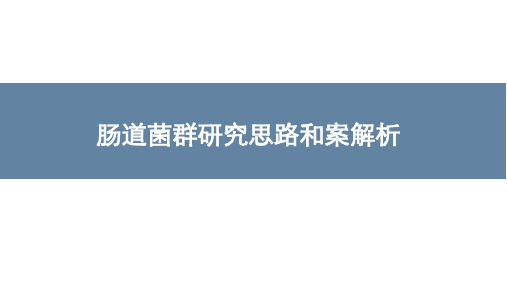
肠道菌群研究思路和案解析1肠道菌群介绍目录216S测序技术介绍3肠道菌群的研究方向和案例分析PART1肠道菌群介绍肠道菌群介绍肠道菌群,顾名思义——生存在人的肠道里的大量细菌构成的集体。
其中包括:有益菌,也称之为益生菌,主要是各种双歧杆菌、乳酸杆菌等,是人体健康不可缺少的要素,可以合成各种维生素,参与食物的消化,促进肠道蠕动,抑制致病菌群的生长,分解有害、有毒物质等。
有害菌,数量一旦失控大量生长,就会引发多种疾病,产生致癌物等有害物质,或者影响免疫系统的功能(如:肺炎克雷伯氏菌等)。
中性菌,即具有双重作用的细菌,如大肠杆菌、肠球菌等,在正常情况下对健康有益,一旦增殖失控,或从肠道转移到身体其他部位,就可能引发许多问题。
常见的肠道菌群:(左上)双歧杆菌,(右上)乳酸杆菌,(左下)肠球菌,(右下)大肠杆菌肠道菌群与疾病肠道微生物参与宿主新陈代谢和免疫系统的调节,并与环境因子相互作用决定机体的健康和疾病状态。
已有大量研究表明,多种疾病与肠道菌群失衡有关。
1:肠道菌群与脑部相关疾病(肠脑轴,如:抑郁症、脑卒中、AD、PD等)2:肠道菌群与代谢性疾病(如:肥胖、糖尿病等)3:肠道菌群与肝脏相关疾病(肠-肝-免疫轴,如:肝硬化、非酒精性脂肪肝等)4:肠道菌群与胃肠道相关疾病(炎症性肠病、肠易激综合症等)5:肠道菌群与肾相关疾病(慢性肾病等)6:肠道菌群与肿瘤…肠道菌群与心血管疾病1:疾病人群和健康人群进行流行病学和队列分析。
2:临床水平疾病菌群和动物模型疾病菌群的表型比较。
3:临床疾病人群粪便进行粪菌移植(FMT ),模拟动物模型。
4:健康人群的粪便进行粪菌移植(FMT ),不会改善人群疾病的行为。
5:临床疾病人群进行干预治疗,可以改善疾病的行为。
肠道菌群常用研究方法短链脂肪酸是肠道菌群代谢产物中最主要的标志物之一。
短链脂肪酸是指碳链中碳原子小于 6 个的有机脂肪酸 ,主要包括 乙酸 、丙酸 、丁酸等 。
作为肠道菌群发酵的主要产物,对人体多个器官和代谢有较大的影响。
藿香正气水调节小鼠肠道菌群失调的作用研究
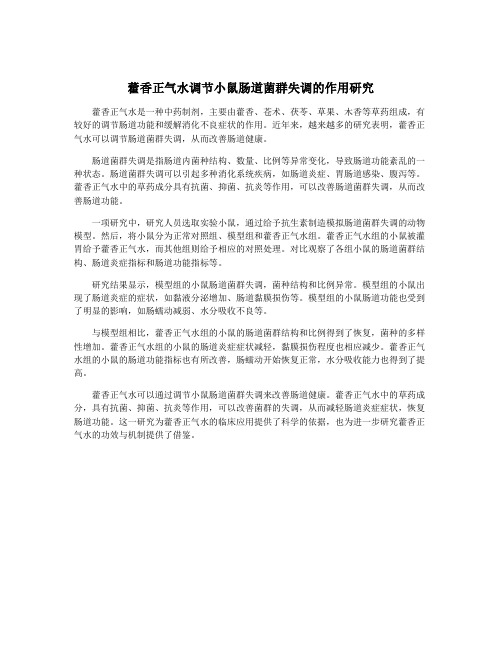
藿香正气水调节小鼠肠道菌群失调的作用研究藿香正气水是一种中药制剂,主要由藿香、苍术、茯苓、草果、木香等草药组成,有较好的调节肠道功能和缓解消化不良症状的作用。
近年来,越来越多的研究表明,藿香正气水可以调节肠道菌群失调,从而改善肠道健康。
肠道菌群失调是指肠道内菌种结构、数量、比例等异常变化,导致肠道功能紊乱的一种状态。
肠道菌群失调可以引起多种消化系统疾病,如肠道炎症、胃肠道感染、腹泻等。
藿香正气水中的草药成分具有抗菌、抑菌、抗炎等作用,可以改善肠道菌群失调,从而改善肠道功能。
一项研究中,研究人员选取实验小鼠,通过给予抗生素制造模拟肠道菌群失调的动物模型。
然后,将小鼠分为正常对照组、模型组和藿香正气水组。
藿香正气水组的小鼠被灌胃给予藿香正气水,而其他组则给予相应的对照处理。
对比观察了各组小鼠的肠道菌群结构、肠道炎症指标和肠道功能指标等。
研究结果显示,模型组的小鼠肠道菌群失调,菌种结构和比例异常。
模型组的小鼠出现了肠道炎症的症状,如黏液分泌增加、肠道黏膜损伤等。
模型组的小鼠肠道功能也受到了明显的影响,如肠蠕动减弱、水分吸收不良等。
与模型组相比,藿香正气水组的小鼠的肠道菌群结构和比例得到了恢复,菌种的多样性增加。
藿香正气水组的小鼠的肠道炎症症状减轻,黏膜损伤程度也相应减少。
藿香正气水组的小鼠的肠道功能指标也有所改善,肠蠕动开始恢复正常,水分吸收能力也得到了提高。
藿香正气水可以通过调节小鼠肠道菌群失调来改善肠道健康。
藿香正气水中的草药成分,具有抗菌、抑菌、抗炎等作用,可以改善菌群的失调,从而减轻肠道炎症症状,恢复肠道功能。
这一研究为藿香正气水的临床应用提供了科学的依据,也为进一步研究藿香正气水的功效与机制提供了借鉴。
氨苄西林钠制备小鼠肠道菌群失调模型的研究
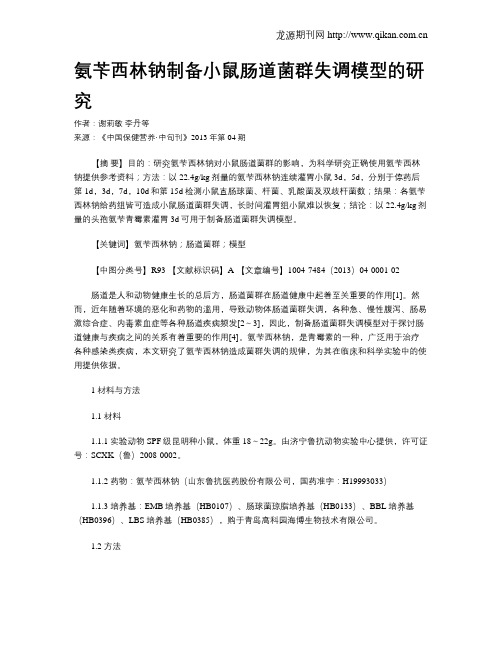
氨苄西林钠制备小鼠肠道菌群失调模型的研究作者:谢莉敏李丹等来源:《中国保健营养·中旬刊》2013年第04期【摘要】目的:研究氨苄西林钠对小鼠肠道菌群的影响,为科学研究正确使用氨苄西林钠提供参考资料;方法:以22.4g/kg剂量的氨苄西林钠连续灌胃小鼠3d,5d,分别于停药后第1d,3d,7d,10d和第15d检测小鼠直肠球菌、杆菌、乳酸菌及双歧杆菌数;结果:各氨苄西林钠给药组皆可造成小鼠肠道菌群失调,长时间灌胃组小鼠难以恢复;结论:以22.4g/kg剂量的头孢氨苄青霉素灌胃3d可用于制备肠道菌群失调模型。
【关键词】氨苄西林钠;肠道菌群;模型【中图分类号】R93 【文献标识码】A 【文章编号】1004-7484(2013)04-0001-02肠道是人和动物健康生长的总后方,肠道菌群在肠道健康中起着至关重要的作用[1]。
然而,近年随着环境的恶化和药物的滥用,导致动物体肠道菌群失调,各种急、慢性腹泻、肠易激综合症、内毒素血症等各种肠道疾病频发[2~3],因此,制备肠道菌群失调模型对于探讨肠道健康与疾病之间的关系有着重要的作用[4]。
氨苄西林钠,是青霉素的一种,广泛用于治疗各种感染类疾病,本文研究了氨苄西林钠造成菌群失调的规律,为其在临床和科学实验中的使用提供依据。
1 材料与方法1.1 材料1.1.1 实验动物 SPF级昆明种小鼠,体重18~22g。
由济宁鲁抗动物实验中心提供,许可证号:SCXK(鲁)2008-0002。
1.1.2 药物:氨苄西林钠(山东鲁抗医药股份有限公司,国药准字:H19993033)1.1.3 培养基:EMB培养基(HB0107)、肠球菌琼脂培养基(HB0133)、BBL培养基(HB0396)、LBS培养基(HB0385),购于青岛高科园海博生物技术有限公司。
1.2 方法1.2.1 实验分组及处理 48只雄性小鼠,随机分为4组,每组12只,分别为:(1)正常对照1组(CK1):生理盐水灌胃,连续灌胃3d,2次/d;(2)氨苄1组(AB1):氨苄西林钠以22.4g/kg的剂量连续灌胃3天,2次/d;(3)正常对照2组(CK2):生理盐水灌胃,连续灌胃5d,2次/d;(4)氨苄2组(AB2):氨苄西林钠以22.4g/kg的剂量连续灌胃5天,2次/d;1.2.2 形态观察每天观察和记录各组小鼠的形态、行为活动以及精神状态。
调节小鼠肠道菌群和预防肠道菌群失调探讨

【 bt c】 O j t e T s bi n a m dl o i e i oar u t nadi eta fr b ac rvno . t- A s at r be i o t lhai l oe fn sn fr e l i n t i o i a nepeetn Me cv ea s m s t t a l g ao l n sn l a m l l i h
【 要】 目的 建立调节 小鼠肠道 茵群 动物模型和预 防肠道 茵群失调 的模 型 , 讨微 生 态调 节剂 不 同的使 用方 法 摘 探
对 肠 道 茵群 失 调 的 作 用 。方 法 ① 预 防 茵群 失 调 : 立 小 鼠肠 道 茵 群 失调 预 防 组 和 对 照 组 模 型 ; 调 节 茵 群 失 调 : 立 建 ② 建
【 关键 词】 双歧 杆菌属 ; 乳酸杆 菌属 ; 动物 【 中图分 类号 】 R一32 3 【 献标识 码 】 A 文 【 文章编号 】 10 —5 120 70 1—3 0400 (08 0—850 J
Esa l h n fmo eso tsn lf r e uain a d itsia o a i aa c rv nin i c . AN o - ~, tbi me to d l fi et a o a r g lt n n et lf r mb ln ep e e t n mie Y G T ̄ #‘ s n i l o n l o
ce t n etn oa i aa c n mie. he h m c fc nrlg o p r c ie ai e a d tI c : t e x e me tlg o sr — r ae itsia f r mb l e i c T n te i e o o to r u e ev d s n n I m e i oh r e p r l l n ’ l ei n i na up e r e ie co c s se rg ltrrs e tv l fr5 d y o i e t a f rs rg lt n. c s smpe h mie wr e tk n b s pt ev d mi re o y tm e uao e p ciey。o a sf r ntsi ll a e uai n o o Fe e a ls o te f c e a e y ae i c ma iua o n utr d fra s sme to mo n f e eo a tra e e, iio a tru a d lco a i u o a rwig i he its np lt n a d c lu e o se s n fa u to ntrb ceic a bfd b ceim n a tb cl s f rs g o n n t ne — i l l
五大急性和慢性肠道炎症动物模型剖析

五大急性和慢性肠道炎症动物模型剖析摘要:炎症的病因是多因素的,因此研究人员和临床兽医需要应用不同的动物模型来模拟人类相关疾病。
那么,知道用于研究哺乳动物急性和慢性肠道炎症性疾病的各种动物模型的相对优势和局限性是极有必要的。
本文旨在说明在每个动物模型的优点和缺点,希望能有助于研究人员在急性或慢性刺激促进肠道疾病模型上的选择。
肠道是一个高度复杂的器官,需要复杂的动物模型来研究其功能和疾病。
在肠道内含有各种消化的食物成分或维持肠道环境的好氧、厌氧和兼性厌氧菌,而这些细菌通常对肠道,和生理和免疫功能有显著的影响。
研究肠道疾病的动物模型从小鼠到非人灵长类动物有很多种,虽然没有一个单一的动物模型是完美的,但对研究肠道炎症来说每个模型都具有独特探索肠道损伤和疾病的各个方面的功能。
小鼠: 小鼠是最常用于肠道研究的动物模型,基因工程小鼠在研究肠道炎症中尤为重要。
IL-10基因敲除小鼠C3H和BALB/c是已知的,比野生型C57BL/6小鼠易自发结肠炎。
另外,C57BL / 6比BALB/c 和C3H/HeJ小鼠更容易诱发Th2细胞介导的结肠炎,TCRα链缺陷的C57BL / 6小鼠比BALB/c和C3H/HeJ更容易诱发结肠炎。
此外,我们都知道用于诱导慢性肠道炎症的化学试剂会受到小鼠遗传背景的影响。
例如,三硝基苯磺酸(TNBS)、化学试剂用于刺激小鼠的CD样症状,很大程度取决于遗传背景;SJL / J,C3HeJ和BALB/c小鼠用TNBS造模,可建立小鼠CD肠病变,而C57BL/6小鼠相同的条件下保持相对不受影响。
同样,瑞士韦伯斯特和C3H/HeJ 葡聚糖硫酸钠(DSS)给药后小鼠发展UC样病变,但C57BL/6小鼠DSS处理后显示较少的组织损伤。
当选择用小鼠来研究肠道损伤时,小鼠和人类微生物组、免疫反应以及单胃的解剖结构之间的相似性也是重要的考虑因素。
小鼠和人在许多肠道特异性基因上有高相似性,且小鼠基因组和人基因组学比较研究得出人类和老鼠的基因90%是共享的,大约80%的基因同源。
槲皮素对肠道菌群的调节作用研究

食品研究与开发F ood Research And Development圆园20年5月第41卷第10期DOI :10.12161/j.issn.1005-6521.2020.10.002槲皮素对肠道菌群的调节作用研究陈樱萌,胡满江,曾钰鹏,丁艺新,丁静华,李瑶璐,陈骁熠*,苏立杰*(广州医科大学公共卫生学院,广东广州511436)摘要:为探究槲皮素对肠道菌群的调节作用,利用光电比浊法动态观察槲皮素在体外对肠道优势菌肠球菌、肠杆菌、乳杆菌和双歧杆菌增殖的影响;利用盐酸林可霉素灌胃构造小鼠肠道菌群失调动物模型,通过小鼠体内实验评价槲皮素调节肠道菌群失调的效果。
体外实验结果表明,在一定浓度范围内(0.01、0.05、0.1μmol/mL )槲皮素对乳杆菌增殖有明显扶植作用,超过这一范围时(0.5、1μmol/mL )对乳杆菌增殖强烈抑制,各浓度槲皮素均对肠球菌的体外增殖表现为强烈的抑制作用,对肠杆菌和双歧杆菌无明显的抑制作用但也不表现出扶植作用;体内实验表明,200、400mg/kg BW 槲皮素可增加小鼠肠道双歧杆菌数量。
槲皮素可调节肠道菌群。
关键词:槲皮素;肠道菌群;菌群失调;增殖;小鼠Study on the Regulation of Quercetin on Intestinal FloraCHEN Ying-meng ,HU Man-jiang ,ZENG Yu-peng ,DING Yi-xin ,DING Jing-hua ,LI Yao-lu ,CHEN Xiao-yi *,SU Li-jie *(School of Public Health ,Guangzhou Medical University ,Guangzhou 511436,Guangdong ,China )Abstract :To investigate the effect of quercetin on the intestinal flora ,photoelectric turbidimetry was used todynamically observe the effect of quercetin on the intestinal dominant bacteria Enterococcus ,Enterobacter ,Lactobacillus and Bifidobacterium in vitro .An animal model of intestinal flora imbalance in mice was constructed by gavage of lincomycin hydrochloride ,and the effect of quercetin on regulating intestinal flora imbalance was evaluated by in vivo experiments in mice.The results of in vitro experiments showed that quercetin had a significant effect on the proliferation of Lactobacillus in a certain concentration range (0.01,0.05,0.1μmol/mL ),beyond this range (0.5,1μmol/mL )strongly inhibited the proliferation of Lactobacillus ,each concentration of quercetin had a strong inhibitory effect on the in vitro proliferation of Enterococcus ,and had no obvious inhibitory effect on Enterobacter and Bifidobacterium ,but did not show enhancement.In vivoexperiments showed that 200and 400mg/kg BW quercetin could increase the number of bifidobacteria in the intestine of mice.Quercetin could regulate intestinal flora.Key words :quercetin ;intestinal flora ;flora imbalance ;proliferation ;mice引文格式:陈樱萌,胡满江,曾钰鹏,等.槲皮素对肠道菌群的调节作用研究[J].食品研究与开发,2020,41(10):6-15CHEN Yingmeng ,HU Manjiang ,ZENG Yupeng ,et al.Study on the Regulation of Quercetin on Intestinal Flora[J].Food Re -search and Development ,2020,41(10):6-15肠道菌群是生活在人体肠道内细菌的统称[1],种类、数量众多,对机体健康发挥着极其重要的作用。
肠道菌群实验设计
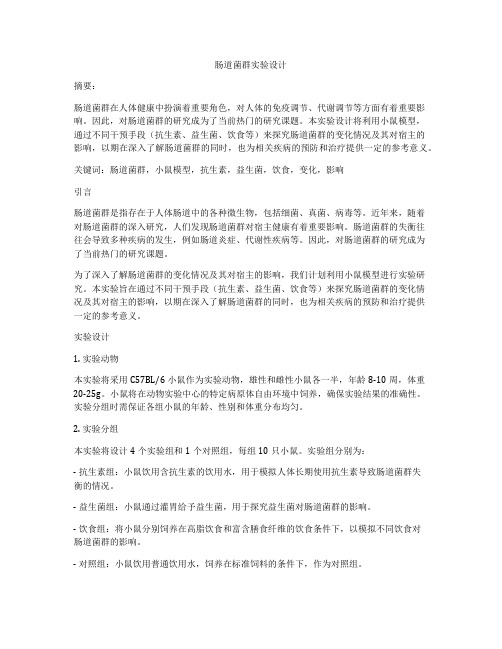
肠道菌群实验设计摘要:肠道菌群在人体健康中扮演着重要角色,对人体的免疫调节、代谢调节等方面有着重要影响。
因此,对肠道菌群的研究成为了当前热门的研究课题。
本实验设计将利用小鼠模型,通过不同干预手段(抗生素、益生菌、饮食等)来探究肠道菌群的变化情况及其对宿主的影响,以期在深入了解肠道菌群的同时,也为相关疾病的预防和治疗提供一定的参考意义。
关键词:肠道菌群,小鼠模型,抗生素,益生菌,饮食,变化,影响引言肠道菌群是指存在于人体肠道中的各种微生物,包括细菌、真菌、病毒等。
近年来,随着对肠道菌群的深入研究,人们发现肠道菌群对宿主健康有着重要影响。
肠道菌群的失衡往往会导致多种疾病的发生,例如肠道炎症、代谢性疾病等。
因此,对肠道菌群的研究成为了当前热门的研究课题。
为了深入了解肠道菌群的变化情况及其对宿主的影响,我们计划利用小鼠模型进行实验研究。
本实验旨在通过不同干预手段(抗生素、益生菌、饮食等)来探究肠道菌群的变化情况及其对宿主的影响,以期在深入了解肠道菌群的同时,也为相关疾病的预防和治疗提供一定的参考意义。
实验设计1. 实验动物本实验将采用C57BL/6小鼠作为实验动物,雄性和雌性小鼠各一半,年龄8-10周,体重20-25g。
小鼠将在动物实验中心的特定病原体自由环境中饲养,确保实验结果的准确性。
实验分组时需保证各组小鼠的年龄、性别和体重分布均匀。
2. 实验分组本实验将设计4个实验组和1个对照组,每组10只小鼠。
实验组分别为:- 抗生素组:小鼠饮用含抗生素的饮用水,用于模拟人体长期使用抗生素导致肠道菌群失衡的情况。
- 益生菌组:小鼠通过灌胃给予益生菌,用于探究益生菌对肠道菌群的影响。
- 饮食组:将小鼠分别饲养在高脂饮食和富含膳食纤维的饮食条件下,以模拟不同饮食对肠道菌群的影响。
- 对照组:小鼠饮用普通饮用水,饲养在标准饲料的条件下,作为对照组。
每个实验组的小鼠将在实验开始前进行无菌消毒处理,以确保实验结果的准确性。
养殖技术中的肠道菌群调理方法
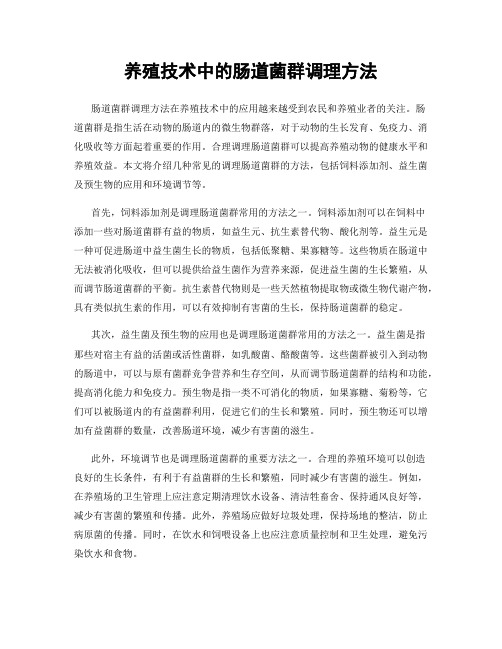
养殖技术中的肠道菌群调理方法肠道菌群调理方法在养殖技术中的应用越来越受到农民和养殖业者的关注。
肠道菌群是指生活在动物的肠道内的微生物群落,对于动物的生长发育、免疫力、消化吸收等方面起着重要的作用。
合理调理肠道菌群可以提高养殖动物的健康水平和养殖效益。
本文将介绍几种常见的调理肠道菌群的方法,包括饲料添加剂、益生菌及预生物的应用和环境调节等。
首先,饲料添加剂是调理肠道菌群常用的方法之一。
饲料添加剂可以在饲料中添加一些对肠道菌群有益的物质,如益生元、抗生素替代物、酸化剂等。
益生元是一种可促进肠道中益生菌生长的物质,包括低聚糖、果寡糖等。
这些物质在肠道中无法被消化吸收,但可以提供给益生菌作为营养来源,促进益生菌的生长繁殖,从而调节肠道菌群的平衡。
抗生素替代物则是一些天然植物提取物或微生物代谢产物,具有类似抗生素的作用,可以有效抑制有害菌的生长,保持肠道菌群的稳定。
其次,益生菌及预生物的应用也是调理肠道菌群常用的方法之一。
益生菌是指那些对宿主有益的活菌或活性菌群,如乳酸菌、酪酸菌等。
这些菌群被引入到动物的肠道中,可以与原有菌群竞争营养和生存空间,从而调节肠道菌群的结构和功能,提高消化能力和免疫力。
预生物是指一类不可消化的物质,如果寡糖、菊粉等,它们可以被肠道内的有益菌群利用,促进它们的生长和繁殖。
同时,预生物还可以增加有益菌群的数量,改善肠道环境,减少有害菌的滋生。
此外,环境调节也是调理肠道菌群的重要方法之一。
合理的养殖环境可以创造良好的生长条件,有利于有益菌群的生长和繁殖,同时减少有害菌的滋生。
例如,在养殖场的卫生管理上应注意定期清理饮水设备、清洁牲畜舍、保持通风良好等,减少有害菌的繁殖和传播。
此外,养殖场应做好垃圾处理,保持场地的整洁,防止病原菌的传播。
同时,在饮水和饲喂设备上也应注意质量控制和卫生处理,避免污染饮水和食物。
肠道菌群调理方法虽然多种多样,但需要根据具体的养殖对象和养殖环境选择适合的方法,并在应用过程中注意合理配比和用量。
动物实验:芍药苷通过调控肠道菌群改善胆汁淤积

动物实验:芍药苷通过调控肠道菌群改善胆汁淤积胆汁淤积肝脏疾病是一种因各种内外原因,导致有毒胆汁酸过度积累或胆汁流量改变,胆管和肝细胞受损的肝脏疾病,胆汁淤积本身也会进一步加重肝脏的损害[1]。
据统计,我国慢性肝病住院患者胆汁淤积肝脏疾病的发生率高达10.26%,在原发硬化性胆管炎患者中发生率高达75%,肝硬化中可达47.76%[2]。
在胆汁淤积疾病过程中,胆汁酸是胆汁的重要成分,约占胆汁固体成分的85%,胆汁酸在肝脏合成后,进入胆管分泌到胆囊,后进入小肠参与食物消化,最后大部分胆汁酸在回肠末端重新吸收,通过门静脉返回肝脏,另有5%的胆汁酸通过粪便排出[3],这个过程为胆汁酸的肝肠循环。
因此,任何造成胆汁酸平衡失调的因素都能导致胆汁淤积的形成。
胆汁酸通过肝肠循环将肠道与肝脏连接起来,肠道菌群可调节经肝脏合成排入肠道的胆汁酸,同时肠道菌群的结构和分布又受胆汁酸的影响。
肠道菌群失调与胆汁淤积性肝病密切相关[4],由于肝脏和肠道经胆管、门静脉和体循环进行双向交流[5],因此肠道菌群失调可能通过肠-肝轴引起肝脏的炎症性疾病[6]。
研究表明,肠道菌群失调,肠内代谢产物包括肠源性毒素和微生物代谢物通过门静脉进入肝脏,引起肝细胞炎症损伤,激活肝脏免疫应答机制,从而导致肝功能改变[7]。
此外,肠道微生物在肝脏病理生理过程中发挥重要作用,能够通过改变肠道通透性、调节胆碱代谢、调节胆汁酸代谢等来改善肝脏炎症和(或)纤维化[8]。
传统中医药理论将胆汁淤积归属于“黄疸”范畴,处方数据挖掘研究表明,治疗淤胆型肝炎的中药复方汤剂中最常用的中药之一为赤芍,使用频率高达82.61%[9]。
赤芍为毛茛科芍药属植物芍药的干燥根,性凉能泻肝胆之热,味苦可入胆而益胆汁,《神农本草经》中述其“主邪气腹痛,除血痹,破坚积,寒热疝瘕,止痛,利小便”[10]。
“瘀”贯穿淤胆型肝炎始终,使用赤芍可清利肝胆热毒、改善脉道瘀阻的状态;现代药理学研究也证实,大剂量赤芍可通过调节转运蛋白的表达,并调节胆汁酸组成和含量,从而改善胆汁淤积[11]。
宠物动物的肠道微生物群研究进展

宠物动物的肠道微生物群研究进展宠物动物是人类生活中重要的伴侣和家庭成员,在宠物养殖业的快速发展下,人们对宠物动物的健康愈发关注。
近年来,研究人员开始关注宠物动物肠道微生物群的重要性,并且在这一领域取得了显著的研究进展。
肠道微生物群对宠物动物的健康起着重要影响,影响着它们的免疫系统、消化功能、心理行为等多个方面。
本文将对宠物动物肠道微生物群研究的进展进行探讨。
一、宠物动物肠道微生物群的组成肠道是宠物动物体内最复杂的微生物栖息地,其中包括细菌、真菌、原生动物等多种微生物。
这些微生物通过与宠物动物的肠道黏膜密切接触,形成肠道微生物群。
根据研究,宠物动物肠道微生物群具有个体差异性,即每个宠物动物的肠道微生物组成都是独特的。
宠物动物肠道微生物群的主要成分是益生菌和有益菌群。
这些微生物对宠物动物的健康产生积极影响,包括帮助消化食物、维持肠道屏障功能、抑制致病菌的生长等。
同时,肠道微生物群中也存在一些有害菌群,如沙门氏菌和大肠杆菌等,它们可能引起宠物动物的肠道感染和疾病。
二、肠道微生物群与宠物动物健康的关系宠物动物的肠道微生物群与它们的健康密切相关。
首先,肠道微生物群对宠物动物的免疫系统起着重要作用。
研究表明,良好的肠道微生物群可以增强宠物动物的免疫力,使其更抵抗疾病。
其次,肠道微生物群还能影响宠物动物的消化功能。
一些微生物可以帮助分解食物中的纤维素和其他难以消化的物质,提供额外的能量和营养。
此外,肠道微生物群还与宠物动物的心理行为有着密切联系。
研究发现,肠道微生物群的失调可能导致宠物动物情绪不稳定和行为异常。
三、调节宠物动物肠道微生物群的方法了解宠物动物肠道微生物群的组成和功能后,人们开始探索调节肠道微生物群的方法。
一种方法是使用益生菌和益生元。
益生菌是指对宿主有益的活性微生物,可以通过口服或饲料添加的方式补充到宠物动物的肠道中,以促进肠道微生物群的平衡。
益生元则是能够维持益生菌生长和活性的营养物质,如低聚糖和纤维素等。
藿香正气水调节小鼠肠道菌群失调的作用研究
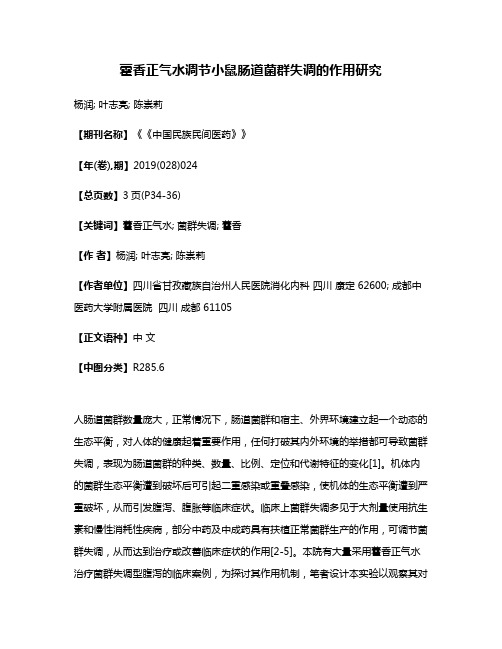
藿香正气水调节小鼠肠道菌群失调的作用研究杨润; 叶志亮; 陈崇莉【期刊名称】《《中国民族民间医药》》【年(卷),期】2019(028)024【总页数】3页(P34-36)【关键词】藿香正气水; 菌群失调; 藿香【作者】杨润; 叶志亮; 陈崇莉【作者单位】四川省甘孜藏族自治州人民医院消化内科四川康定 62600; 成都中医药大学附属医院四川成都 61105【正文语种】中文【中图分类】R285.6人肠道菌群数量庞大,正常情况下,肠道菌群和宿主、外界环境建立起一个动态的生态平衡,对人体的健康起着重要作用,任何打破其内外环境的举措都可导致菌群失调,表现为肠道菌群的种类、数量、比例、定位和代谢特征的变化[1]。
机体内的菌群生态平衡遭到破坏后可引起二重感染或重叠感染,使机体的生态平衡遭到严重破坏,从而引发腹泻、腹胀等临床症状。
临床上菌群失调多见于大剂量使用抗生素和慢性消耗性疾病,部分中药及中成药具有扶植正常菌群生产的作用,可调节菌群失调,从而达到治疗或改善临床症状的作用[2-5]。
本院有大量采用藿香正气水治疗菌群失调型腹泻的临床案例,为探讨其作用机制,笔者设计本实验以观察其对菌群失调的影响。
1 实验材料1.1 实验动物 SPF级昆明种小鼠60只,雌雄各半,体重18~22 g。
由四川省中医科学院实验动物中心提供,合格证号:SCXK(川)2013-19,饲养温度18~22℃,相对湿度58%~62%,喂食颗粒标准饲料,自由饮水和摄食,每2天更换1次垫料,正常饲养3d后供试,实验前小鼠饮水、进食正常,状态良好。
1.2 药品与试剂乳酶生片(批号160408,桂林南药股份有限公司);盐酸林可霉素针剂(批号160611,天津金耀氨基酸有限公司);藿香正气水(160607,太极集团有限公司);Anaero Gen 2.5 litre(英国Oxoid);琼脂粉、牛肉浸膏、蛋白胨、酵母浸膏(广东环凯生物科技有限公司);L-半胱氨酸(上海伯奥生物科技有限公司);伊红美兰培养基(EMB)、改良MRS培养基、改良MC培养基、EC培养基;其余试剂均为分析纯。
藿香正气水调节小鼠肠道菌群失调的作用研究

藿香正气水调节小鼠肠道菌群失调的作用研究藿香正气水(Huo Xiang Zheng Qi Shui)是一种中药复方制剂,由藿香、苍术、白术、陈皮等中草药经过科学配方组成。
自古以来,藿香正气水就被广泛地应用于中华传统医学中,被认为有助于调节肠道功能,缓解腹泻、腹痛等症状。
近年来,随着肠道微生态的研究逐渐深入,越来越多的研究表明藿香正气水可能通过调节肠道菌群失调的作用发挥其药效。
本研究旨在探讨藿香正气水对小鼠肠道菌群失调的调节作用,以期为中药复方制剂在肠道微生态失调相关疾病的临床应用提供科学依据。
一、材料与方法1. 实验动物:使用健康的C57BL/6J小鼠,雄性,6-8周龄,体重22-25g,从实验动物中心购买。
2. 藿香正气水制备:按照药典要求,选取藿香、苍术、白术、陈皮等药材,按照一定比例配方,制成藿香正气水。
3. 建立小鼠肠道菌群失调模型:将小鼠随机分为对照组和模型组,模型组采用广谱抗生素饲料诱导肠道菌群失调。
4. 药物处理:按体重给予小鼠相应的藿香正气水处理,对照组给予等量生理盐水。
5. 采集样本:在药物处理后,采集小鼠的粪便样本,用16S rRNA基因测序技术对肠道菌群进行分析。
6. 统计分析:使用SPSS 20.0软件对实验数据进行统计学分析,采用t检验或方差分析进行比较。
二、结果1.藿香正气水可以显著缓解抗生素诱导的小鼠肠道菌群失调。
2.藿香正气水处理组与对照组相比,肠道微生态多样性指数明显提高。
3.藿香正气水处理组中部分益生菌数量明显增加,有益菌/有害菌比值显著增加。
4.藿香正气水处理组中某些产气菌、蛋白质分解菌和脂肪酸生成菌的数量明显减少。
5.对照组中存在明显的肠道炎症反应,而藿香正气水处理组中肠黏膜炎症程度显著降低。
三、讨论需要指出的是,本研究还存在一些不足之处,比如只采用了小鼠模型,尚未开展人体临床试验,研究结果还需在更多类型的动物和人体中进行进一步验证。
肠道微生态对人体健康的影响是一个复杂的系统工程,藿香正气水的作用机制还有待深入研究。
- 1、下载文档前请自行甄别文档内容的完整性,平台不提供额外的编辑、内容补充、找答案等附加服务。
- 2、"仅部分预览"的文档,不可在线预览部分如存在完整性等问题,可反馈申请退款(可完整预览的文档不适用该条件!)。
- 3、如文档侵犯您的权益,请联系客服反馈,我们会尽快为您处理(人工客服工作时间:9:00-18:30)。
Establishment of Models of Intestinal Flora Regulation and Intestinal Flora Imbalance Prevention in Mice
GAO Yun , LIANG Shang - dong , MU Song - niu , ZHANG Yu - zhen , XU Bao - hua , LIU Zheng - yu , J IANGJian - mei
(The Faculty of Laboratory Animal Science , Jiangxi Medical college , Nanchang 330006 ,China)
(雌雄各半) 随机分成 4 组 ,每组 10 只 。灌服抗生素 溶液 (抗生素种类及剂量同前) 同时分别加生理盐 水 ,微生态调节剂 ,20 %低聚果糖及中药 (同前) ,012 mlΠ只 ,每天 2 次 ,连续 5 d 。于最后 1 次给受试物 24 h 后 ,无菌采取小鼠粪便 ,经稀释后选择适当的稀释 度 ,分别接种在各培养基上培养双歧杆菌 (BS 培养 基) ,乳杆菌 (LC 培养基) ,肠杆菌 ( EMB 培养基) 及肠 球菌 ( EC 培养基) ,48~72 h 之后计数 。
【Abstract】 Objective To establish animal models of intestinal flora regulation and intestinal flora imbalance prevention. Methods 11 The animal model of intestinal flora regulation :40 mice used in this experiment were randomly divided into 4 groups , each of 10 mice. Antibiotics were used for 3 days to create intestinal flora imbalance in mice. Then the mice of control group received saline and the mice in other 3 experimental groups received microecosystem regulator , fructose and traditional Chinese medicine , respectively , for 5 days for intestinal floras regulation. Feces samples of the mice were taken by aseptic manipulation and cultured for assessment of amount of enterobacteriaceae , bifidobacterium and lactobacillus floras growing in the intestine. 21 The model of intestinal flora imbalance prevention : 40 mice were randomly divided into 4 groups , each containing 10 mice. Along with the antibiotics , the mice in the 4 groups received saline , microecosystem regulator , fructose and traditional Chinese medicine , respectively , for 5 days. Samples of feces of the mice were taken after the completion of experiment and the amount of bacterial floras were assessed with the same procedure as in the first experiment. Results 11 The model of intestinal flora regulation :Compared with the control group using saline , all the 3 experimental groups showed that bifidobacterium , lactobacillus floras and intestinal bacillus were significantly increased after treatment with the microecosystem regulator , fructose and traditional Chinese medicine , respectively. 21 The model of intestinal flora imbalance prevention : Compared with the control group using normal saline , the bifidobacterium , lactobacillus floras and intestinal bacillus were significantly increased in the 3 experimental groups after treatment with microecosystem regulator , fructose and traditional Chinese medicine , respectively. Conclusion The
2005 年 6 月 第 15 卷 第 3 期
中国比较医学杂志 CHINESE JOURNAL OF COMPARATIVE MEDICINE
June , 2005 Vol . 15 No. 3
研究报告
调节肠道菌群和预防肠道菌群失调动物模型探讨
高 云 ,梁尚栋 ,穆松牛 ,张玉珍 ,许宝华 ,刘征宇 ,姜建梅
1 材料和方法
111 材料 11111 实验动物 : KM 小鼠 80 只 ,雌雄各半 ,体重 18 ~22 g ,江西医学院实验动物科学部提供 ( 合格证 号 :02196002) 。 11112 试剂 :盐酸林可霉素 (100 mgΠml) ,江西国药 有限公司 ,批号 :0110192 ; 头孢唑林钠 (100 mgΠml) , 江西国药有限公司 ,批号 :0110112 ;氨苄西林钠 (100 mgΠml) ,江西国药有限公司 ,批号 : 0107102 ; 微生态 调节剂 (主要成份为双歧杆菌 ,蜡样芽胞杆菌) ,大连 医科大学微生态学研究所保存菌种 ; 20 %低聚果 糖 ,湖南省益阳生化试剂厂 批号 :20011108 ;中药 (主 要成份为党参 、白术 、茯苓 、甘草等) 。 112 实验方法 11211 调节肠道菌群动物模型 :选用 40 只小鼠 (雌 雄各半) 随机分成 4 组 ,每组 10 只 。先采集小鼠正 常粪便检测肠道菌数量 ,然后灌服抗生素溶液 (用 pH 714 的生理盐水配制的盐酸林可霉素 ,头孢唑林 钠及氨苄西林钠的混合液 ,3 种抗生素的浓度均分 别为 100 mgΠml) ,012 mlΠ只 ,每天 2 次 ,连续 3 d 。经 检验小鼠肠道出现菌群失调 ,随机选取 1 组以生理 盐水灌胃 ,作为自然恢复组 ; 其余 3 组分别灌服微 生态调节剂 (主要成份为双歧杆菌 ,蜡样芽胞杆菌) , 20 %低聚果糖及中药 (含党参 、白术 、茯苓 、甘草等) , 012 mlΠ只 ,每天 2 次 ,连续 5 d 。于最后 1 次给受试 物 24 h 后 ,无菌采取小鼠粪便 ,经稀释后选择适当 的稀释度 , 分别接种在各培养基上培养双歧杆菌 (BS 培养基) ,乳杆菌 (LC 培养基) ,肠杆菌 ( EMB 培 养基) 及肠球菌 ( EC 培养基) ,48~72 h 之后计数 。 11212 预防肠道菌群失调动物模型 : 用 40 只小鼠
(江西医学院实验动物科学部 ,南昌市 330006)
【摘要】 目的 建立调节肠道菌群动物模型和预防肠道菌群失调动物模型 。方法 ⑴调节肠道菌群动物模 型 小鼠灌服抗生素溶液 ,小鼠肠道菌群失调后 ,随机选取 1 组以生理盐水灌胃 ,作为自然恢复组 ,其余 3 组分别 灌服微生态调节剂 (主要成份为双歧杆菌 ,蜡样芽胞杆菌) ,20 %低聚果糖及中药 (含党参 、白术 、茯苓 、甘草等) ,给 受试物后无菌采取粪便 ,观察各组双歧杆菌 ,乳杆菌 ,肠杆菌及肠球菌数量 。 ⑵预防肠道菌群失调动物模型 小鼠 灌服抗生素溶液同时分别加生理盐水 ,微生态调节剂 ,20 %低聚果糖及中药 (同前) ,给受试物后无菌采取粪便 ,观 察各组双歧杆菌 ,乳杆菌 ,肠杆菌及肠球菌数量 。结果 ⑴调节肠道菌群动物模型 菌群失调后 ,给予微生态调节 剂 ,果糖及中药后 ,小鼠肠道内的双歧杆菌 ,乳杆菌及肠杆菌在小鼠肠道内的数量与自然恢复组相比较明显增加 ; ⑵预防肠道菌群失调动物模型 给予微生态调节剂 ,果糖及中药后 ,与正常对照组相比较小鼠肠道内的双歧杆菌 , 乳杆菌及肠杆菌的数量明显增加 。结论 微生态调节剂 ,果糖及中药可产生调节小鼠肠道菌群 ,增殖双歧杆菌和 乳杆菌的作用 。
中国比较医学杂志 2005 年 6 月第 15 卷第 3 期 Chin J Comp Med , June 2005 ,Vol . 15. No. 3
165
microecosystem regulator , fructose and traditional Chinese medicine may excert effects to prevent the intestinal flora imbalance and increase the bifidobacterium , lactobacillus and intestinal bacillus floras in the intestine.
